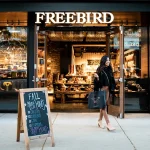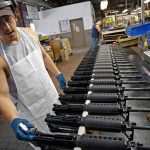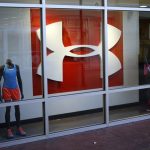Spirits are high for the Holiday 2010 selling season after aggressive promotions, pent-up consumer demand and colder weather patterns drove retail chains to their best November in four years. If a stellar Black Friday and steady sales throughout the fiscal month was any indication, consumers have finally returned to the aisles in search of non-necessities at deeply discounted prices, of course.
Same-store sales were up a healthy 5.8% from November 2009, according to the International Council of Shopping Centers, which tracks 31 major retail chains, excluding Wal-Mart. In early November, the ICSC had forecast consolidated comps would improve between 3.0% and 3.5%, but the association said the aforementioned factors, along with easy comparisons versus the year-ago period, propelled results handily past estimates.
Resourceful retailers got creative with their promotions in November, turning to layaway programs, cut-rate online sales, Thanksgiving Day promotions, credit card reward programs and aggressive Black Friday promotions, effectively setting the stage for a crucial December that will be a “make or break” month for Holiday 2010.
Merchants remain optimistic for the time being, however, as the Black Friday and Cyber Monday barometric selling periods showed promising precursors for the near future – especially from an eCommerce standpoint. Based on a report from Coremetrics, a unit of IBM that tracks online traffic, Internet sales were up a healthy 12% on Black Friday this year, with average orders up by the same amount to $190.80 from $170.19. Sales for traditional brick n’ mortar channels were up just 0.3% to $10.7 billion, according to ShopperTrak, somewhat disappointing compared to a year-ago period that was still very much in the midst of a historic spending depression.
“While Black Friday weekend is not always an indicator of holiday season performance, retailers should be encouraged that a focus on value and discretionary gifts has shoppers in the spirit to spend,” said Matthew Shay, NRF president and CEO.
Retailers Stay Optimistic for December, but…
Indeed, while expectations for December are high, more than a few economists have suggested that strong November sales were more a sign of earlier shopping than a general increase in spending. After all, October apparel sales suffered from warm weather that dampened demand a factor that certainly led to a spike in November apparel sales coinciding with the arrival of winter weather. November was also up against a warm November last year, making the weather conversation all the more compelling this year.
Trigger-happy retailers also had a hand in pushing the shopping season back, as many launched pre-Black Friday sales as early as Monday and others opened their doors on Thanksgiving Day to get a jump on Christmas shoppers.
December will be a telling period in determining whether or not any faction of the “full-priced” consumer has returned, and retailers may find that they’ll have to prolong deep, margin-crushing discounting to move product out the door. “As retailers look ahead to the first few weeks of December, it will be important for them to keep momentum going with savings and incentives that holiday shoppers simply can’t pass up,” said NRF’s Shay.
Likewise, a market-wide shift to more online shopping is likely here to stay, as scrupulous consumers clearly prefer the ability to price compare from the comfort of their home. According to a survey conducted for the National Retail Federation over the Black Friday weekend, the percentage of people who shopped online during the weekend rose 15.2%, from 28.5% last year to 33.6% this year. A report from comScore indicated that online spending was up 9% to $648 million on Black Friday.
ICSC said it continues to maintain its holiday sales forecast of 3.0% to 3.5% growth for the November-December period, although analysts said the strong November performance will likely result in an “upward revision in holiday-season sales” by a half to a full percentage point. ICSC anticipates December sales will be up by 3.0% to 3.5%, in line with Holiday 2010 forecasts.
The positive results from the big stores appear to have also extended smaller shops as well.
SportsOneSource sent out an e-mail blast in the middle of last week asking subscribers how they felt about Holiday 2010 trends based on Black Friday weekend and Cyber Monday results. Overall, most respondents projected gains over last year with more than a few predicting a very merry season.
Alan Blume, owner of Vertical Drop Ski & Snowboard in Cincinnati, said that based on early trends, he's projecting a 15% to 20% increase for his store for December with “very strong” ski and ski boot sales and a more modest gain in snowboards. Snowy weather is also helping his region. Said Blume, “Vendors are running out of product and anybody that is not reordering key categories now will be left out in the cold.”
Richard Fredericks, president at H.R.F. & Associates, agreed that it looks like a strong ski season. He said, “Since there is little product showing up online, skiers have gravitated back to ski shops and found what they're looking for at competitive pricing. Distributors are running out of product so the ski industry should be very clean by season's end.”
On the other hand, Andy Schepper, director of e-commerce at Summit Sports, indicated that Black Friday through Cyber Monday bought increases of more than 100% over 2009. Added Schepper, “We are hoping to see similar increases in December.”
A few lamented that much of the action over Black Friday weekend as well as Cyber Monday went the big boxes offering the doorbuster deals and other steep discount drivers.
Specialty Retailers See a Mixed Bag as Big Boxes Steal Most of the Attention…
For Looking Glass Outfitters Outfitter in Pisgah Forest, NC, Black Friday was a “bust” despite deep discounts but steady traffic in the days before and after the weekend have made up for it. Hot categories for the outdoor retailer include women's down jackets and parkas, men's synthetic parkas, ice climbing accessories, as well as hats and gloves.
The bike category, as usual for the season, appears to be off to a slow start, at least according to a bike rep and a store owner. The owner of one bike shop sin the Southeast, who wished to remain anonymous, said, “We are showing a little improvement but it is coming from existing consumers who have been putting off purchases or are replacing equipment.”
Some noted the new, crafty promotions the retail industry continues to come up with every year. Katy Gaenicke, owner of the KGPR PR firm, pointed to the enormity of coupon deals this season. “Seems like there are so many websites that offer promo codes, cash-back shopping, etc. that nobody should pay full price for anything,” said Gaenicke. “Sites like ShopAtHome.com and Groupon.com are changing the way we shop online.”
Howie Ellis, VP of sales at outerwear brand Sunice, believes the holiday season will ultimately come down to jobs. “If one has a job, that consumer feels more secure this year than last and is spending money this holiday,” said Ellis. “If you don't have a job, you are probably working to pay down debt and will be very value conscious with spending. As a result, growth over LY will be minimal, probably in the 2-3% range, all of which is driven by those with jobs. We are at least another year away (provided unemployment drops to the mid-single-digits) from a banner holiday buying season.”
Ellis may have hit on the right cautionary note that may hold consumers back from posting a record-breaking holiday shopping period. On Friday, the U.S. Dept. of Labor reported an unexpected increase in U.S. unemployment late last week, which is a disappointing development for economists and business hoping for a rebound. The unemployment rate in November rose to a seven month high as employers only added a disappointing 39,000 jobs. Economists had expected about 145,000 would be added. The unemployment rate for the month was 9.8%, up from 9.6% in October, sobering news for retailers hoping for some sort of respite from limited spending. Economists warned rates could hover above 9% for several years as companies struggle to recover from the recession and continue to retrain current employees to fill new responsibilities.
Retailers and vendors both are keeping a close eye on inflationary pressures even as consumers are clearly demanding lower prices.
Bruce Berton Ex. VP COO Roochi Traders Inc., a distributor of sportswear and activewear, said that though volumes are up, margins on commodity items such as t-shirts, fleece and active sportswear will eventually be hurt by rising cotton prices, particularly in 2011.
Mike May, director of communications at SGMA, believes it's too soon to call the holiday season. He notes that traditional sporting goods stores will be competing with giants such as Wal-Mart and Target.
Department Stores Lead Healthy Comp Growth
By retail segment, ICSC reported that department stores were once again the pacesetter for November retail sales gains, with the luxury sub-segment up 5.3% on average. Nordstrom (+5.1%), which has been a solid performer in recent months, exceeded forecasts on strength from jewelry and shoes along with a bi-annual sales for women and kids. Neiman Marcus (+5.5%) beat estimates on significant growth in Texas, the Southeast and New York City, while Saks Inc. (+5.3%) saw healthy year-over-year growth but missed estimates.
Results were even better for the mid-tier department stores, with J.C. Penney (+9.2%) turning in a stellar fiscal month on strength from its largest Black Friday event ever and growth in all divisions and regions. “Customers are responding very well to our gift assortments as well as taking advantage of our great promotions in order to buy for themselves,” said company Chairman and CEO Mike Ullman, III.
Macy’s (+6.1%) heftily beat Wall Street’s estimates and raised profit outlook for Q4 while Kohl’s (+6.1%) more than doubled forecasts on increased store traffic and strength in the Southwest and South Central regions. At Dillard’s (+8.0%), strong sales of shoes and juniors’/children’s clothing propelled comps past expectations while Stage Stores (+2.4%) slightly missed forecasts but “remains optimistic about the holiday season.”
It was business-as-usual for the teen segment, which grew about 9% on a consolidated basis but had its usual bad apples weighing down results. Most notable of those was Aeropostale (-1.0%), which was consistently stronger-than-average during the depths of the recession but has since struggled as key competitors have cut selling prices to keep pace. During a recent presentation, management for Aeropostale issued a disappointing Q4 forecast and announced that co-CEO Mindy Meads is stepping down.
On the other end of the scale, Abercrombie & Fitch (+22.0%) more than tripled analysts’ forecasts in a continuation of what has been a somewhat-unexpected revival for a brand that was reporting comps losses in the mid-twenties just a year ago. A&F, which finally succumbed to stubborn consumers by slashing selling prices, has also benefitted recently by strength from its surf-themed Hollister chain.
Among other notables, Gap (+4.0%) beat estimates on strength from its Gap (+5%) and Old Navy (+5%) stores while American Eagle (flat) missed estimates on weakness during “non-peak” periods and The Wet Seal (+7.0%) soared above forecasts on a revamped merchandise assortment and a strong Black Friday.
Among Discounters, Ross Stores (+6.0%), Target Stores (+5.5%) and TJX Companies (+3.0%) outperformed forecasts. Carol Meyrowitz, CEO of TJX Cos., said customer traffic continued to be up during November and Thanksgiving week traffic was “brisk.”
At Kohl’s (+6.1%), which more than doubled comp forecasts, management said shoes and young women’s clothing drove results, although the company continues to expect a 1% to 2% drop in comps for December and January. At Stein Mart (flat), strength from women’s underwear and men’s sportswear was diluted by weakness in plus-sized women’s clothing and casual sportswear.
For warehouse clubs, comps were up 7.0% on a consolidated basis, with Costco (+9.0%) easily outpacing projections due to higher gas prices and a weaker dollar and BJ’s Wholesale (+5.0%) up on strength from the Southeast region. Excluding fuel sales and inflation, comps were up 6.0% and 3.8% for Costco and BJ’s, respectively.
Zumiez November Comps Up 20.7%…
Zumiez reported comparable store sales increased 20.7% for the four-week period ended Nov. 27 compared to an 8.5% decline in the year-ago period. Total sales increased 26.2% to $40.4 million for the month from $32.0 million in the year-ago period. Comparable sales growth was driven by an increase in comparable store transactions. ZUMZ said that dollars per transaction were down due to a decrease in average unit retail and a decrease in units per transaction.
Men's accessories, footwear, juniors and hardgoods posted positive comps while boys posted negative comps.
ZUMZ’s highest comping region was the South, which was up 26% for the month.
The Buckle’s Comps Up 7.9% for Nov…
The Buckle reported that November comparable store sales increased 7.9% while total net sales increased 12.5% to $86.9.1 million for the month.
On the men's side of the business, which represented approximately 38% of total sales for the month, sales were up about 17.5% but overall price points were down approximately 2.5% for the period. Women's sales, which represented about 62% of total sales, were up approximately 9.5% versus the prior-year period.
Overall price points on the women's side of the business were up approximately 1.5%.
Accessory sales increased 24.5% for the month, while footwear sales increased 8.5% for the period.















